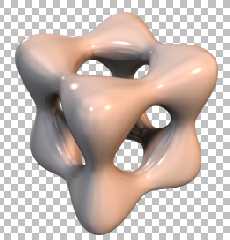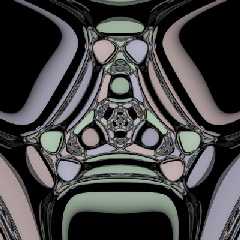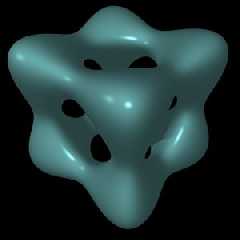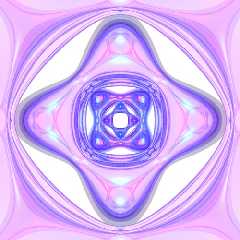 |
 |
|
 |
|
 |
|  |
|  |
|
 |
|
 |
|  |
|  |
|
 |
Hello.
Some time ago I was thinking about features of POV-Ray I've missed. I
wanted to learn POV-Ray and SDL features more deeply. There are a lot of
them, so, I decided to start with primitives. Here is the result of quartic
exploration. I like it and I hope, it is interesting for somebody.
------------------------
#declare a=1;
#declare b=-1.5;
#declare R=1;
quartic {
<
a,0,0,0,0,
0,0,0,0,b,
0,0,0,0,0,
0,0,0,0,0,
a,0,0,0,0,
b,0,0,0,0,
a,0,b,0,R
>
sturm
}
------------------------
Sincerely Yours,
Alex Kluchikov.
Post a reply to this message
Attachments:
Download 'quartic.jpg' (32 KB)
Preview of image 'quartic.jpg'

|
 |
|  |
|  |
|
 |
|
 |
|  |
|  |
|
 |
"S. Cinar" <nob### [at] home com> wrote:
> That's the FormEx3D logo :)
> ( X^6+Y^6+Z^6+X^4+Y^4+Z^4-X^8-Y^8-Z^8-2=0 )
Sorry, but it is not FormEx3D logo :)
The one I sent is
( X^4+Y^4+Z^4-1.5*X^2-1.5*Y^2-1.5*Z^2+1=0 )
Sincerely Yours,
Alex Kluchikov. com> wrote:
> That's the FormEx3D logo :)
> ( X^6+Y^6+Z^6+X^4+Y^4+Z^4-X^8-Y^8-Z^8-2=0 )
Sorry, but it is not FormEx3D logo :)
The one I sent is
( X^4+Y^4+Z^4-1.5*X^2-1.5*Y^2-1.5*Z^2+1=0 )
Sincerely Yours,
Alex Kluchikov.
Post a reply to this message
|
 |
|  |
|  |
|
 |
|
 |
|  |
|  |
|
 |
Thank you. I think that's just the shape I was looking for.
Post a reply to this message
Attachments:
Download 'q8b.jpg' (39 KB)
Preview of image 'q8b.jpg'

|
 |
|  |
|  |
|
 |
|
 |
|  |
|  |
|
 |
Mmmm... preeeety :-D
Post a reply to this message
|
 |
|  |
|  |
|
 |
|
 |
|  |
|  |
|
 |
Alex Kluchikov wrote:
> Hello.
> Some time ago I was thinking about features of POV-Ray I've missed. I
> wanted to learn POV-Ray and SDL features more deeply. There are a lot of
> them, so, I decided to start with primitives. Here is the result of quartic
> exploration. I like it and I hope, it is interesting for somebody.
<snip:tech />
My rhoids'll love it!
--
Respectfully,
Dan P
http://<broken link>
Post a reply to this message
|
 |
|  |
|  |
|
 |
|
 |
|  |
|  |
|
 |
Dave Matthews wrote:
> Thank you. I think that's just the shape I was looking for.
There is something oddly sensual about this one!
--
Respectfully,
Dan P
http://<broken link>
Post a reply to this message
|
 |
|  |
|  |
|
 |
|
 |
|  |
|  |
|
 |
Alex,
I also came across that form, in a book actually. It is called
the "tanglecube", which you can find on Mathworld, at
mathworld.wolfram.com/Tanglecube.html . It is neat to see it again. I
used it in MegaPOV I think, so now I'll try it in POV 3.5.
-Ben Scheele
"Alex Kluchikov" <klk### [at] ukr net> wrote in message
news:408d0ae3@news.povray.org...
> Hello.
> Some time ago I was thinking about features of POV-Ray I've missed.
I
> wanted to learn POV-Ray and SDL features more deeply. There are a lot
of
> them, so, I decided to start with primitives. Here is the result of
quartic
> exploration. I like it and I hope, it is interesting for somebody.
> ------------------------
> #declare a=1;
> #declare b=-1.5;
> #declare R=1;
> quartic {
> <
> a,0,0,0,0,
> 0,0,0,0,b,
> 0,0,0,0,0,
> 0,0,0,0,0,
> a,0,0,0,0,
> b,0,0,0,0,
> a,0,b,0,R
> >
> sturm
> }
>
> ------------------------
>
> Sincerely Yours,
> Alex Kluchikov.
>
>
> net> wrote in message
news:408d0ae3@news.povray.org...
> Hello.
> Some time ago I was thinking about features of POV-Ray I've missed.
I
> wanted to learn POV-Ray and SDL features more deeply. There are a lot
of
> them, so, I decided to start with primitives. Here is the result of
quartic
> exploration. I like it and I hope, it is interesting for somebody.
> ------------------------
> #declare a=1;
> #declare b=-1.5;
> #declare R=1;
> quartic {
> <
> a,0,0,0,0,
> 0,0,0,0,b,
> 0,0,0,0,0,
> 0,0,0,0,0,
> a,0,0,0,0,
> b,0,0,0,0,
> a,0,b,0,R
> >
> sturm
> }
>
> ------------------------
>
> Sincerely Yours,
> Alex Kluchikov.
>
>
>
Post a reply to this message
|
 |
|  |
|  |
|
 |
|
 |
|  |
|  |
|
 |
"Ben T. Scheele" <sch### [at] tc umn umn edu> wrote in message
news:40917e61$1@news.povray.org...
>
> I also came across that form, in a book actually. It is
called
> the "tanglecube", which you can find on Mathworld, at
> mathworld.wolfram.com/Tanglecube.html . It is neat to see it again.
I
> used it in MegaPOV I think, so now I'll try it in POV 3.5.
I had not realised how easy it could be converting an expression to
use in an isosurface.
This was my first attempt:
<Mathsworld>
A quartic surface given by the implicit equation
x^4 - 5x^2 + y^4 - 5y^2 + z^4 - 5z^2 + 11.8 = 0
</Mathsworld>
#declare Tanglecube =
function{ pow(x,4) + pow(y,4) + pow(z,4)
- pow(x,2)*5 - pow(y,2)*5 - pow(z,2)*5
+ 11.8 }
isosurface { function{ Tanglecube(x,y,z)-1 }
contained_by { box { -3, 3 } }
max_gradient 86
}
Alf edu> wrote in message
news:40917e61$1@news.povray.org...
>
> I also came across that form, in a book actually. It is
called
> the "tanglecube", which you can find on Mathworld, at
> mathworld.wolfram.com/Tanglecube.html . It is neat to see it again.
I
> used it in MegaPOV I think, so now I'll try it in POV 3.5.
I had not realised how easy it could be converting an expression to
use in an isosurface.
This was my first attempt:
<Mathsworld>
A quartic surface given by the implicit equation
x^4 - 5x^2 + y^4 - 5y^2 + z^4 - 5z^2 + 11.8 = 0
</Mathsworld>
#declare Tanglecube =
function{ pow(x,4) + pow(y,4) + pow(z,4)
- pow(x,2)*5 - pow(y,2)*5 - pow(z,2)*5
+ 11.8 }
isosurface { function{ Tanglecube(x,y,z)-1 }
contained_by { box { -3, 3 } }
max_gradient 86
}
Alf
Post a reply to this message
Attachments:
Download 'Tanglecube.jpg' (7 KB)
Preview of image 'Tanglecube.jpg'

|
 |
|  |
|  |
|
 |
|
 |
|  |
|  |
|
 |
Yep, you got it, Alf! Isosurfaces rule, don't they? Here's what I did
using a few of them.
-Ben
> I had not realised how easy it could be converting an expression to
> use in an isosurface.
>
> This was my first attempt:
>
> <Mathsworld>
> A quartic surface given by the implicit equation
> x^4 - 5x^2 + y^4 - 5y^2 + z^4 - 5z^2 + 11.8 = 0
> </Mathsworld>
>
> #declare Tanglecube =
> function{ pow(x,4) + pow(y,4) + pow(z,4)
> - pow(x,2)*5 - pow(y,2)*5 - pow(z,2)*5
> + 11.8 }
>
> isosurface { function{ Tanglecube(x,y,z)-1 }
> contained_by { box { -3, 3 } }
> max_gradient 86
> }
>
> Alf
Post a reply to this message
Attachments:
Download 'Tanglecube-b.jpg' (49 KB)
Preview of image 'Tanglecube-b.jpg'

|
 |
|  |
|  |
|
 |
|
 |
|  |
|  |
|
 |
"Ben T. Scheele" <sch### [at] tc umn umn edu> wrote in message
news:40942762@news.povray.org...
> Isosurfaces rule, don't they? Here's what I did
> using a few of them.
Nice one.
Alf edu> wrote in message
news:40942762@news.povray.org...
> Isosurfaces rule, don't they? Here's what I did
> using a few of them.
Nice one.
Alf
Post a reply to this message
|
 |
|  |
|  |
|
 |
|
 |
|  |
|
 |




![]()